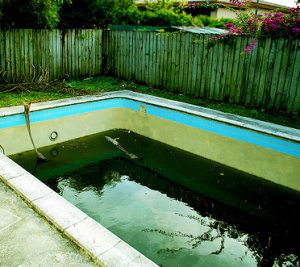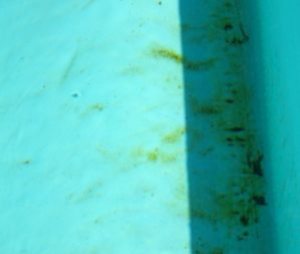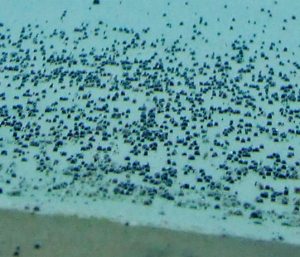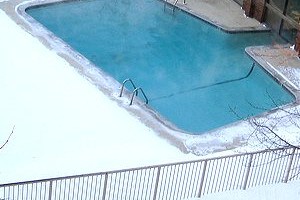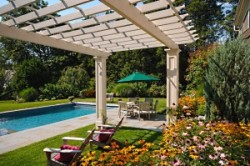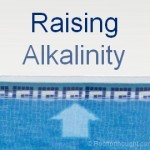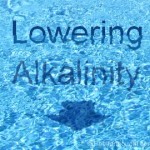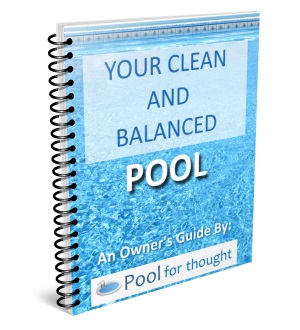
Many different types of algae exist, and knowing which type of algae is in your pool is important to determine how to both remove algae growth and prevent future algae blooms. This article will focus on types of algae, potential dangers, cleaning algae, and preventing further buildup.
What types of algae are found in swimming pools?
Green Algae
Green algae is the most common type of algae that you might find in your pool. As the name implies, green algae appears typically in various shades of green, but can also appear yellow-green and blue-green in color. Green algae floats and grows free in the water, but also easily attaches itself to surfaces in the pool water. What may feel like an unusually slippery surface may actually be a thin film of green algae growing on the surface. Green algae can also float in patches in areas where there is little to no water circulation. It can spread quickly across your pool, in rapid growth spurts called an algae bloom. These algae blooms are the result of exponential algae growth and multiply quickly in the right conditions. Left untreated, green algae overwhelms the typical chlorine, bromine, biguanide, or other sanitizer method in your pool. The algae growth will continue on the pool and water surfaces, causing discolorations and staining of pool surfaces, and eventually clog water filters and putting a strain on pool pumps.
If you notice your pool water has a green hue, you may have small-celled green algae growing in the water. If your swimming pool water tests negative for metals like copper, you likely have small-celled green algae growing in your pool. The water may appear clear or have a slightly hazy appearance, with the distinction is that small-celled green algae makes the water look clear green.
Yellow, or Mustard Algae
Mustard algae gets its name from its yellow or yellow-orange color, and it is also called yellow algae. It is similar to green algae in consistency, although it can form in more coherent clumps, along with a dusty or powdered appearance on pool walls and floors. Yellow algae prefers shaded areas of the pool, and will likely be the first place to look if you suspect you have an algae problem or live in areas prone to mustard algae growth. Typical places to look for yellow algae are behind ladders and under water slides, on the vertical faces of shaded stairs, and near any decorative stone formations that block sunlight from entering areas of the pool.
Mustard algae spores are much smaller than most green algae, so they often pass through pool water filters, making it difficult to remove. It can come back easily and quickly without proper treatment. Mustard algae sticks to everything and can reform if you do not take everything out of the pool before treating it.
Black, or Blue-Green Algae
Black algae, also called blue-green algae, is the worst kind of algae for swimming pools, mainly due to its rugged ability to survive even after efforts to clean it from the infected pools. Early black algae formation is noted by small black dots on pool floors and walls or sides, often in shaded areas and areas with crevices, cracks, or imperfections in pool surfaces. They quickly grow to round, coin-sized patches, either in black or dark blue-green hues. Black algae grows in layers. The initial algae spores roots to the surface and into the crack or crevice. The successive outer layers coat and protect the layers beneath, ending with a waxy coating that makes it difficult to penetrate.
Black algae should be taken care of early as it is easy to identify in its early stages. Algaecides and even shocking the pool have little effect on black algae growth. Pool skimmer interior surfaces are notorious for black algae growth, as flowing pool water keeps the surfaces moist, yet the skimmer blocks out most of the light.
Pink algae
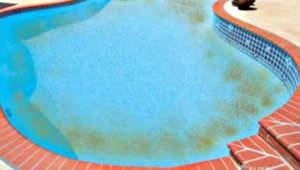
Pink algae growing around the edges of a pool. You can also find pink algae growing along coping surfaces, on tile grout, and along pool stairs and steps.
Pink algae in pools can also present a problem for swimming pools. Although not actually an algae at all, it is the result of bacteria growing in rapidly expanding colonies. The pink color is the result of pink or reddish color pigments in its cells. It is being included because it has similar properties to algae and requires a similar algaestat treatment. Pink algae can be found around ladders, lights, and in corners. It is pink or dark pink and is heavier than water, so it tends to grow towards the bottom of swimming pools and away from sunlight. It has a slime coating which protects the bacteria colony, and it can be very difficult to remove. As the bacterium that grows into pink algae is found naturally and freely floating in the air, swimming pool water is constantly being bombarded. Prevention is the best measure to prevent pink algae from gaining a foothold.
Is swimming pool algae dangerous?
Ugly? Yes. Annoying? Yes. Dangerous? Generally, algae is not dangerous to humans. Algae grows naturally in rivers, lakes, and oceans which swimmers enter every day. Additionally, algae farms culture, grow, and harvest large quantities of algae that are then processed into health supplements. Nobody enjoys walking outside for a swim only to see a thick film in the pool that requires cleaning, although you could technically spend an afternoon in the pool without issue.
The danger from algae does not come from algae directly. However, when swimming pool water is not taken care of for long periods of time, algae can grow and multiply and become a comfortable home for harmful microbes. It is the bacteria among these microbes that can have a negative health effect on swimmers if exposed to it. Untreated algae formation can also become home to a host of other harmful microorganisms. This problem is easy to prevent, though, and will be discussed below.
Preventing algae in swimming pools.
Preventing algae is as easy as just maintaining a healthy and balanced pool water environment. Take these precautionary steps, below, to ensure that algae formation does not occur in your pool:
Make sure your filters are regularly cleaned.
You may have multiple filters in your pool water filtration system. Sand filters, a water pump filter, and skimmer basket are common filters. If these become plugged, the amount of water passing through them decreases, giving the opportunity for algae to attach easier to walls and surfaces. Additionally, filters can catch algae spores and give algae an opportunity to grow on other material plugging the filter surface.
Keep your swimming pool water pH level balanced.
Maintain a pool water pH level between 7.4 and 7.6, and continuously monitor the pH level of your pool water. Although keeping a pH-balanced pool still allows for algae to grow (algae grows between 6.5 and 12.5 pH), a proper pH level helps maintain the other water balance levels in your pool, and enables chlorine to be most effective at sanitizing the water.
Regularly brush your pool.
Brush the walls, floor, steps, and any hard to reach places once per week. Brushing your swimming pool breaks up any algae formations attempting to make your pool their home, and makes sanitizers like chlorine or bromine more effective. Look for any areas with cracks, crevices, or shaded areas in the pool, and brush these areas thoroughly.
Keep your pool chlorine level at 2 ppm.
Keeping your chlorine levels at 2 ppm (parts-per-million) will ensure you have enough chlorine to either kill algae already growing in the pool, or keep the algae growth rate down between algaecide treatments to your pool water. Regularly test your pool water chlorine, up to once per day during the warm summer months and whenever you use the pool. The best thing you can do to give algae a chance to thrive in your pool is let your chlorine level drop to zero. With no sanitizer, there is nothing in your water stopping algae from growing in your pool. Algaecides do help, but they are only effective with the use of a sanitizer.
Do not let fertilizers enter your pool water.
The nitrogen in fertilizers are natural algae food. You may have read about how excess lawn fertilizer runoff drains into local ponds and rivers and causes widespread algae blooms. This could happen to you pool if fertilizer enters your pool water. If your property has drainage issues, rainwater can pickup fertilizer in the lawn and drain into the swimming pool. Spreading lawn fertilizer near an uncovered pool is another way fertilizer can access your pool water.
Consider a salt-chlorine generator or chlorinator.
A salt-chlorine generator can help maintain pool water chlorine levels and also kill algae before it forms. You can also install a chlorinator to help maintain the chlorine levels. Dropping several chlorine pucks into the chlorinator every few days greatly reduces the time and headaches of adding daily chlorine treatments.
[sc:ad_leaderboard_google]Cleaning algae from swimming pools.
Cleaning algae can be an arduous task and does require some patience and precision, but is worth the time to ensure you can use your pool as often as you would like without incurring problems. Below are the general steps used to eliminate the various algae types discusses earlier.
- Vacuum and remove as much loose debris as possible in the water.This is to clear out as much organic material as possible to give the next step (shocking the pool) the maximum effect and give the shock the opportunity to focus on the contaminates you cannot remove with a net, including the algae. Do not brush yet, as you do not yet want more loose and alive algae growths floating freely in your pool water.
- Clean out all your filters. Make sure your pool can circulate the water as efficiently as possible by cleaning out all your filters, including backwashing your sand filter if you have one. Your pool pump should be on and circulating the water.
Shock the pool water.When shocking, use a 30,000 ppm or greater available chlorine if you use chlorine in your pool to sanitize. If you use bromine as your sanitizer, use a bromine shock product. You can determine how much shock product to use by trying our shocking for algae control calculator for swimming pools.
- For green algae: You’ll know you have added enough shock when after a pool water has absorbed the shock, the pool water will turn a grayish-blue color.
- For black algae: You make have to shock several times.
- For mustard algae: a normal shock will do.
- For pink algae: a normal shock at a lower pH level (7.2-7.3) will help.
Brush the pool surfaces. Brush all the walls and floors of the pool, even areas where you do not see the algae growth. The idea here is to break the bond the algae has with the pool surface to help the shock do a better job of fully surrounding each algae growth. An added benefit of brushing after adding shock is to keep the shock product moving around in the pool water. This reduces the time the shock sits on the pool bottom, potentially bleaching colored patterns in your pool floor.
- For green algae: Brush thoroughly and evenly. Assume the green algae has touched every surface of your pool (it has).
- For black algae: For black algae on walls and floors, first brush thoroughly as described for green algae. If you still see traces of the black algae, you may have to brush by hand if you cannot apply enough brushing pressure with a brush on a pole. You will have to drain the pool down to the affected area, so if the black algae is on the floor, you may have to drain the pool completely.
- For mustard algae: Be sure to brush everything, including ladders, steps, and accessories. Also wash bathing suits, scrub toys, water floats, etc.
- For pink algae: Brush all walls and floors, but pay close attention to brushing the areas where you see the pink algae. Any missed spot is simply a place for the pink algae to continue growing.
- Let the pool shock do its job.Test the chlorine level later in the day if you used a chlorine-based shock. Test again twice per day until you see the chlorine drop to 3 ppm. At this point make sure you are resuming your normal sanitation routine.
Add an algae-specific algaecide once per week.
- For green algae: Use an algaecide specific or green algae. Poly 60 will work fine as an alternate.
- For black algae: Alternate treatments of Poly 60 and a 7% copper-based algaecide, following the product directions closely for both. The copper level in your water will increase, but this is normal and expected. It’s important to jump to step 7 below and watch the combined chlorine level. When it reaches zero, do not add anymore copper-based algaecide and continue with just weekly poly 60 treatments.
- For mustard algae: Yellow Out or Mustard Buster works well, following the directions on the product label.
- For pink algae: Use an initial treatment of Poly 30 or Poly 60, then apply another treatment again a few days later. Then start weekly treatments.
- Test for combined chlorine.Test the total chlorine and free chlorine levels. If they are not the same number then you have combined chlorine in your pool. This may not yet indicate you still have algae in your pool, as the shock may still working away at oxidizing the organic compounds in your pool. However, if the chlorine has bottomed out to the normal 1-3 ppm level and combined chlorine is still present, then you should shock the pool again (back to step 3).
- Once again clean out your pool filters and backwash if you have a sand filter.
Tips on keeping algae out of your swimming pool:
[sc:ad_leaderboard_google]- Try to shock the pool with chlorine in late afternoon. You want to avoid shocking the pool in sunlight, as the ultraviolet rays quickly destroy the sanitation abilities of chlorine.
- For stubborn algae growths from black and mustard algae, you will have to brush by hand, then apply algaecide directly to the affected areas. For concrete pools, you can also request an acid wash from your local pool contractor. However, you want to minimize acid washes, as these are very hard on pool surfaces.
- Avoid attempting to pour granulated shock directly on algae growths on floors or steps. Vinyl pool patterns can easily be bleached white by shock allowed to sit on these surfaces for extended periods of time.
- Though this likely will not be the case for you, extreme cases of algae might require a pool drain and acid wash to ensure that the algae has been thoroughly and properly disposed of. This occurs only in extreme cases of black algae.
- Be patient. Sometimes algae takes several attempts to finally rid your pool of the problem.
- Once you are confident your pool algae problem is gone, commit to regular algae preventative maintenance to keep the algae from once again gaining a foothold in your swimming pool.
- Avoid keeping the pool uncovered on windy days when not using it, and promptly remove debris that has blown or fallen into the pool water. Both scenarios contribute greatly to giving algae a chance to overwhelm your pool water sanitation and begin growing in the water.
Pool For Thought Pool Store
Here are all the items discussed in this article. Everything you need keep algae from forming in your pool, and rid your pool of algae if you happen to encounter algae growth:
![]()
Conclusion
If your chlorine level is steady at 1-3 ppm, the other water balance levels of pH, alkalinity, and hardness are all balanced, you have no combined chlorine in your pool, your water is clear, and you have no suspicious growths or discolorations on your pool walls or floors, then you likely have eliminated algae from your pool. As an added bonus, your water is now well-balanced, sanitized, and ready for swimming.
If you have algae in your pool, don’t think that you have failed your duties as a pool maintainer. Most pool owners have problems with algae, and most algae problems are not necessarily the owners fault. Follow the steps above to prevent and treat pool algae problems. As with keeping other water balance levels in check, prevention is always easier, less costly, and less stressful than correcting problems.
Sources:
- United States Dept. of the Army. (1986). Swimming Pool Operation and Maintenance, Headquarters, Dept. of the Army.
- California State Water Resources Control Board, pH Fact Sheet, https://www.waterboards.ca.gov/water_issues/programs/swamp/docs/cwt/guidance/3140en.pdf
Photo Credits:
- Green algae: PoolCenter.com
- Mustard Algae: A-Z Pool Care
- Black Algae: Pool Man, Inc.
- Pink Algae: Leslies Pool
